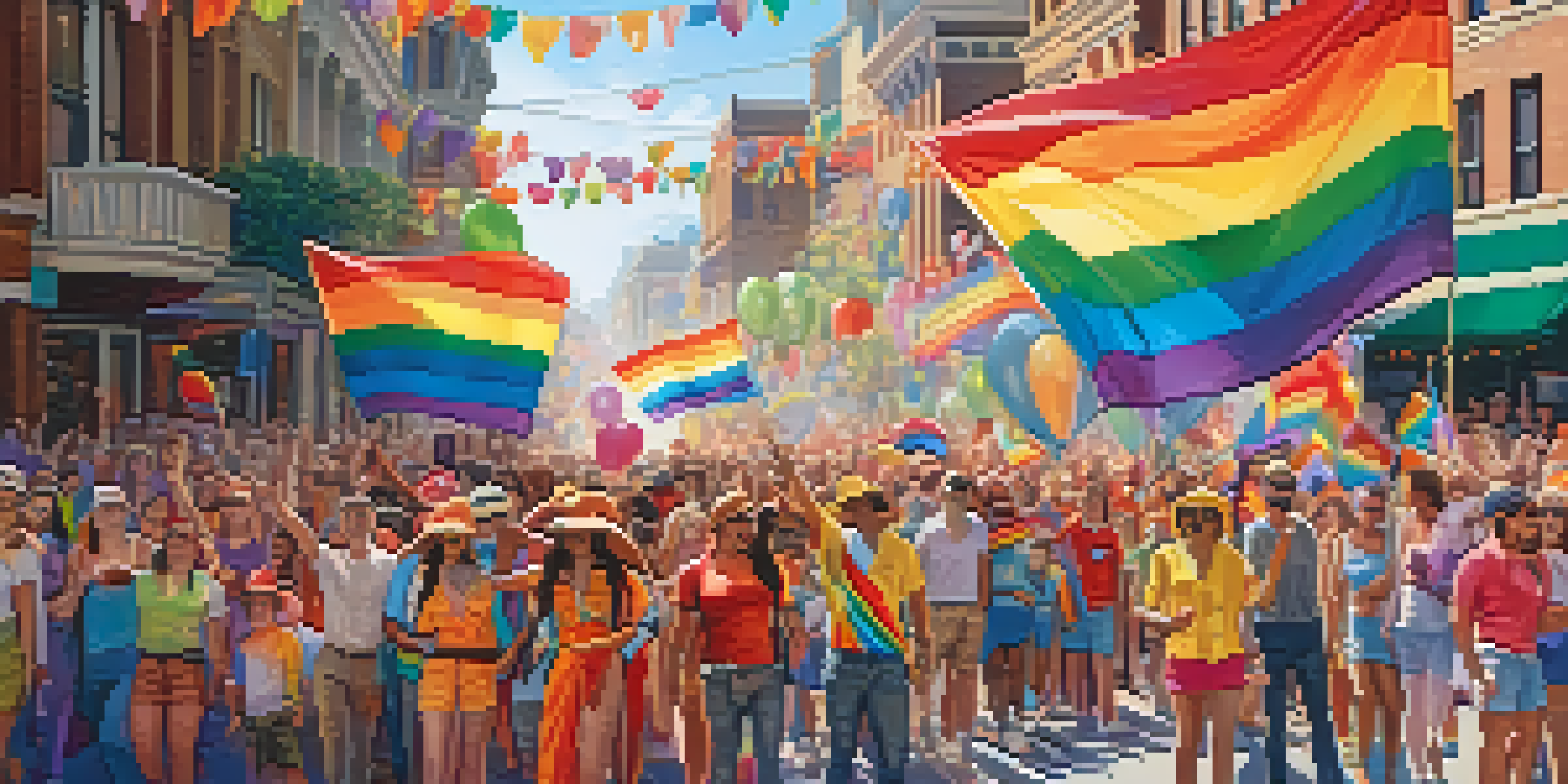Fashion Statements: Clothing as a Form of Political Protest

The Historical Role of Fashion in Political Movements
Fashion has long been intertwined with political activism, serving as a canvas for social commentary. For instance, the suffragettes in the early 20th century used their clothing to symbolize their fight for women's rights. By wearing white dresses, they created a visual statement that distinguished them from their opponents, capturing public attention.
Fashion is the armor to survive the reality of everyday life.
Similarly, the Black Panther Party adopted a distinct style that included leather jackets and berets, which projected strength and unity. This choice of attire was not merely about aesthetics; it was a calculated move to assert identity and rally support for civil rights. Through these examples, we see how fashion becomes a voice for the voiceless.
In contemporary society, movements like Black Lives Matter have embraced fashion as a tool for awareness. T-shirts emblazoned with powerful slogans not only unite participants but also invite conversations on systemic racism, showing how clothing continues to be a crucial medium for political expression.
Clothing as a Symbol of Resistance
Clothing can act as a powerful symbol of resistance against oppressive systems. Think of the pink hats worn during the Women’s March in 2017; these hats became an iconic representation of solidarity and defiance. They not only united diverse groups of women but also made a statement about their rights and values.

In Iran, women have used fashion to challenge strict dress codes imposed by the government. By choosing to wear their hijabs loosely or opting for vibrant colors, they are making a bold statement about their freedom of choice. Each act of defiance serves as a reminder that clothing can convey rebellion and resilience.
Fashion as Political Expression
Throughout history, fashion has served as a powerful medium for political activism, allowing individuals and movements to convey their messages and assert their identities.
These instances show that clothing is not just about personal style; it embodies a collective spirit of resistance. When individuals wear these symbols, they join a larger narrative, making their political stance visible in everyday life.
The Impact of Social Media on Fashion Activism
In today’s digital age, social media amplifies the reach of fashion as a form of political protest. Platforms like Instagram and TikTok allow activists to share their messages quickly and visually. For example, a single post featuring a protest outfit can inspire thousands to join the movement or adopt similar styles.
Clothes mean nothing until someone lives in them.
Hashtags play a crucial role in this landscape, creating online communities around shared values. When people use tags like #FashionForFuture, they not only raise awareness but also foster discussions on sustainability and climate change through their clothing choices. This interconnectedness turns fashion into a global dialogue.
Moreover, social media gives rise to new voices in fashion activism. Emerging designers and influencers often blend style with political commentary, challenging the traditional fashion hierarchy and democratizing the conversation around what clothing can represent.
Fashion in the LGBTQ+ Rights Movement
The LGBTQ+ rights movement has harnessed fashion as a form of empowerment and identity expression. Pride parades showcase a vibrant array of colors and styles, with the rainbow flag symbolizing diversity and acceptance. Each outfit becomes a declaration of one’s identity and a celebration of love.
Historical figures, like Marsha P. Johnson, used fashion to disrupt societal norms. Their bold choices challenged traditional gender roles and encouraged others to embrace their true selves. This form of self-expression is not only personal but also serves as a catalyst for broader societal change.
Social Media Amplifies Fashion Activism
In the digital age, platforms like Instagram and TikTok have transformed fashion activism, enabling rapid sharing of political messages and fostering global conversations.
As the movement continues to evolve, so does its fashion. Designers are increasingly creating collections that celebrate queer identities, further embedding political messages into their work and allowing individuals to wear their pride on their sleeves—literally.
Fashion Statements in the Environmental Movement
Environmental activism has found a strong ally in fashion, with many brands adopting sustainable practices to convey their political stance. Clothing made from recycled materials or ethically sourced fabrics reflects a commitment to the planet. This shift in consumer behavior encourages individuals to think critically about their fashion choices.
Notably, the 'slow fashion' movement advocates for quality over quantity, urging consumers to invest in timeless pieces rather than fast fashion trends. This approach not only reduces waste but also promotes a more thoughtful relationship with clothing. Each garment tells a story, encapsulating values of sustainability and responsibility.
Fashion shows and campaigns now frequently incorporate environmental messages. Designers are using their platforms to highlight issues like climate change, urging consumers to make conscious decisions about their wardrobe. In this way, fashion becomes a rallying cry for environmental justice.
The Role of Fashion Designers in Political Activism
Fashion designers have increasingly taken on activist roles, using their influence to advocate for political change. High-profile designers, such as Stella McCartney and Vivienne Westwood, are vocal about issues like animal rights and climate change, incorporating these themes into their collections. Their work not only challenges industry norms but also encourages consumers to think critically about their purchases.
Some designers create pieces specifically to raise funds for social causes. For instance, T-shirts or accessories sold with a portion of the proceeds going to charity can transform a simple clothing item into a tool for activism. This not only raises awareness but also builds a community of supporters around a cause.
Designers as Activist Voices
Fashion designers are increasingly using their influence to support political causes, creating collections that challenge norms and promote awareness around social issues.
Through their platforms, designers can inspire change beyond the runway. Their collections often reflect current events, turning fashion into a medium for political expression that resonates with audiences on a global scale.
The Future of Fashion as Political Protest
As society continues to evolve, the intersection of fashion and political protest will likely become even more pronounced. Young activists are already leading the charge, using fashion as a way to express their values and challenge the status quo. The rise of Gen Z influencers demonstrates a shift towards more conscious consumerism, where style aligns with purpose.
Emerging technologies, such as 3D printing and sustainable fabrics, are paving the way for innovative designs that reflect political messages. Imagine clothing that changes color based on environmental conditions or garments that are fully biodegradable—these concepts could redefine how we think about fashion and activism.

Ultimately, the future of fashion as a political protest tool lies in its ability to adapt and resonate with new generations. As long as clothing remains a reflection of identity and beliefs, it will continue to be a powerful medium for change.